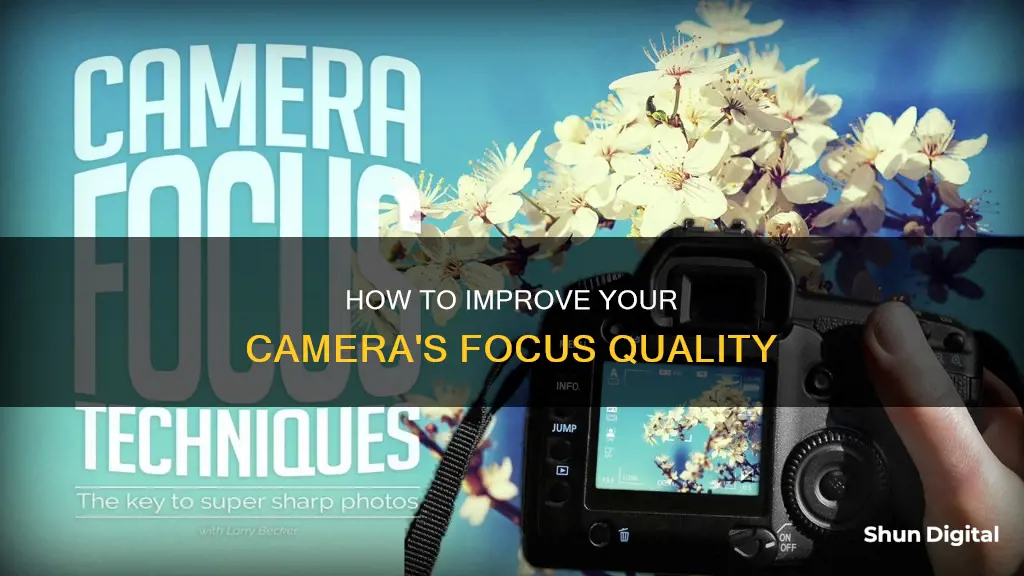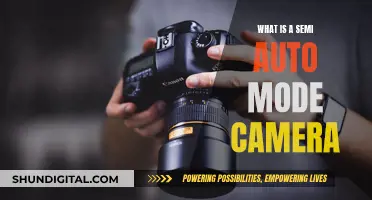
Focusing is a crucial aspect of photography. If you don't focus properly, you will end up with blurry photos even when all your other camera settings are correct. Focusing can be done manually or automatically. Autofocus is a comparatively new invention in the history of photography, first appearing on the market in 1977. Most photographers use autofocus more often than manual focus. However, manual focus is useful when your camera is having trouble focusing, such as in dark conditions, as it lets you override any issues.
The autofocus system in your camera works by having light hit the autofocus sensor, which then determines if the scene appears in focus. If it’s not in focus, it tells the autofocus motor to move the lens element(s) in the direction it ‘thinks’ will bring the scene into focus. The autofocus motor then moves the lens elements, and the autofocus sensor tells the lens to stop focusing when the object becomes focused.
Even though autofocus technology is very advanced, it still has its limitations. If it was perfect, we would never have an out-of-focus image and would never need to switch to manual focus. The great thing to remember is that autofocus works ‘most’ of the time. If you know what it has trouble with, then you can start to look for situations where you need to either pay closer attention to the focus or switch to manual focus.
| Characteristics | Values |
|---|---|
| Camera mode | Manual or autofocus |
| Focus ring | Twist until the subject is sharp |
| Focus distance | Set the focus distance and position the subject at that distance |
| Zoom | Zoom in on the subject for a shallow depth of field |
| Aperture | Use the largest aperture setting to blur the background |
| Shutter speed | Use a faster shutter speed to decrease brightness |
| ISO | Set ISO to 100 or 200 in well-lit conditions |
What You'll Learn

Use manual focus
Manual focus is a useful skill to have as a photographer, as it gives you more control over your images. While autofocus is convenient and has improved over the years, there are still times when manual focus is the better option.
When to Use Manual Focus
Manual focus is particularly useful in low-light situations or when shooting at high magnifications, as autofocus tends to struggle in these scenarios. It can also be beneficial when you want to achieve specific effects, such as keeping the object closest to the lens out of focus while focusing on a subject further away. Additionally, when shooting panoramas, manual focus can help maintain consistency throughout the shots.
How to Use Manual Focus
To use manual focus, first locate the focusing mode switch on your camera or lens, usually labelled "AF/MF", and switch it to "MF". Then, find the focus ring, which is often near the middle or end of the lens barrel. Look through your camera's viewfinder and twist the focus ring to bring your subject into focus. You can also use your camera's LCD screen in live view mode to fine-tune the focus.
Tips for Manual Focusing
- Practice focusing manually to improve your skills.
- When focusing on a person, focus on their eyes to ensure they appear sharp in the image.
- Use a wide aperture to create a soft focus or blur the background.
- Measure the distance from a still subject to the lens for perfect focus.
- Use the "quick-and-dirty method" by focusing on the closest and farthest objects in the frame and then adjusting the focus ring halfway between those distances.
How Focus Screens Impact Camera Focusing Performance
You may want to see also

Adjust the depth of field
Adjusting the depth of field is one of the most important concepts in photography. It is the zone of sharp focus within a picture, and it can be manipulated to create a variety of effects. Here are some ways to adjust the depth of field:
Adjust the aperture settings on your camera
The aperture is the opening in your lens that lets light pass through to the sensor. Think of it as the pupil of your eye, which dilates to let more light in and contracts to restrict light. A wider aperture will result in a shallower depth of field, while a smaller aperture will produce a deeper depth of field.
Change the distance between the camera and the subject
The distance between the camera and the subject also affects the depth of field. The closer the camera is to the subject, the shallower the depth of field will be. This is because the transition from sharp to unsharp focus is gradual, and the area that appears acceptably sharp is larger when the camera is further away.
Understand the focal length of your lens
The focal length of a lens is its ability to magnify a distant subject. It is the length between the sensor in your camera and the area of the lens where light rays converge to create a sharp image. A shorter focal length will result in a wider angle of view and lower magnification, while a longer focal length will have the opposite effect.
Use a combination of these factors
By manipulating a combination of aperture settings, distance to the subject, and focal length, you can create a variety of effects. For example, if you want to achieve an ultra-shallow depth of field, use a wide aperture, get very close to your subject, and use a telephoto lens. On the other hand, if you want to achieve a deep depth of field, use a small aperture, move further away from your subject, and use a wide-angle lens.
Use focus stacking for extreme magnifications
If you are dealing with extreme magnifications in macro photography or still-life photography, you may not be able to get everything in focus in a single shot. In this case, you can use a technique called focus stacking, where you capture a series of shots with slightly different focus points and blend them together in post-processing to extend the zone of sharpness.
Charging Your JVC GR-D850U Camera: Alternative Methods
You may want to see also

Focus on a single point
Focusing on a single point is a great way to improve your photography and get the exact shot you want. It gives you hyper-control over how you focus and compose your scene.
How to Focus on a Single Point
To focus on a single point, you need to use the single-point autofocus (AF) mode. This mode allows you to move the autofocus point to where your subject is in the frame, and the camera will focus on that point.
To do this, you will need to change the autofocus settings on your camera. On a Canon, you can usually find a dedicated AF point selection button. On a Nikon, you will likely find it in the AF menu under AF Area Mode.
Once you have selected the single-point AF mode, you can compose your photo by pointing directly at the part of your subject that you want to be in focus. Then, half-press the shutter button to focus, and the camera will beep, flash, or display a green dot to show that it has focused. Now, you can recompose your shot while keeping your finger half-pressed on the shutter button, and then press it all the way down to capture the photo.
Benefits of Focusing on a Single Point
The single-point AF mode gives you precise control over what is in focus in your photo, allowing you to achieve the desired depth of field. It also enables you to use techniques like the rule of thirds effectively, as you can focus on your subject even if it is not in the centre of the frame.
Additionally, using the single-point AF mode with the "one-shot" or "AF-S" focus mode can be beneficial. This combination allows you to focus on your subject, recompose your shot, and then capture the photo without the camera continuously trying to adjust the focus. This gives you more flexibility in composing your images.
When Not to Focus on a Single Point
While focusing on a single point is advantageous in most situations, there are times when you might want to use different autofocus settings. For example, if you are photographing a fast-moving subject, such as a bird in flight, it may be challenging to keep a single autofocus point on the subject. In such cases, you might want to use multiple AF points or a continuous autofocus mode to track the subject's movement.
In conclusion, focusing on a single point is a valuable technique to master in photography. It gives you precise control over your focus and composition, allowing you to capture the exact shot you envision. However, it is also important to know when to use other autofocus settings to adapt to different photographic situations.
Understanding Camera Batteries: Powering Your Photography
You may want to see also

Focus on the eyes
Focusing on the eyes is one of the most important aspects of portrait photography. We are naturally drawn to a person's eyes, so if they are in focus, the whole image will appear to be in focus.
- Ensure your shutter speed is high enough. Even a small movement of the subject or camera shake can cause motion blur, especially with today's high-resolution cameras. A good rule of thumb is to shoot at a faster speed than the reciprocal of your focal length. For example, if you are shooting at a focal length of 100mm, your shutter speed should be at least 1/100 of a second.
- Use a smaller aperture. While many photographers like to use wide apertures to create a blurry background, this can result in a very narrow depth of field, leaving little margin for error. Stopping down to f/2.8 or higher will help ensure the eyes are in focus. Alternatively, you can increase the distance between the subject and the background to achieve a similar effect without opening up the aperture.
- Use single-point focus. Modern cameras have impressive focus systems that can automatically detect and focus on a person's face. However, for greater precision, try using a single-point focus mode and moving the focus point over the eyes. Sony, for example, has an "eye auto-focus" mode that finds and focuses on the subject's eyes.
- Move your focus point, not the camera. The "focus and recompose" method can change the location of the focal plane, especially when shooting with a wide aperture and at a closer distance. Instead, move the focus point on the camera to the eyes while keeping the camera still.
- Ensure there is enough light on the eyes. Light creates contrast and sharpness, so pay attention to how much light is hitting the eyes when composing your shot. You can also brighten the eyes slightly during post-processing, but this is no substitute for getting enough light during the shot.
- Sharpen the eyes during post-processing. If you are shooting in RAW format, you will need to apply a certain amount of sharpening to the image. Increase the default sharpening in your RAW editor and use the "masking" slider to target only the higher-contrast areas.
- Calibrate your lens. If you have tried all the above tips and are still ending up with soft eyes in your images, your lens may need to be calibrated. This is not an issue with mirrorless cameras, but for DSLR cameras, you may need to make adjustments to the calibration of each lens.
Live Mode: iOS Camera's Hidden Feature
You may want to see also

Use autofocus
Autofocus is a comparatively new invention in the history of photography, first appearing on the market in 1977. It is a useful feature, as it allows you to press a button on your camera and have it focus on your chosen subject, or choose one for you if you prefer.
Most photographers use autofocus more often than manual focus. The main reasons for this are convenience, speed, and accuracy. Autofocus is particularly useful for sports and wildlife photographers. However, manual focus still has its uses. For example, if your camera is struggling to focus in dark conditions, manual focus lets you override any issues or make precise adjustments that the camera may have missed.
If you are using autofocus, it is recommended that you use single-servo for typical landscape and architectural photography, and continuous-servo for most other images, such as wildlife or sports. Single-servo mode means that once your camera acquires focus, it won't readjust until you let go of the focusing button. Continuous-servo mode means that your camera will continuously adjust focus whenever you hold down the focusing button.
There are a few different autofocus area modes to choose from, and the right one for you will depend on the type of photography you are doing. Single-point autofocus, for example, is good when your camera and subject aren't moving, as the camera uses one focusing point. Dynamic autofocus is good for wildlife photography, as you can select a single focusing point, and the camera can then track your subject if it moves into some of the surrounding points.
If you are using autofocus, there are a few things you can do to help your camera focus. Firstly, make sure that there is plenty of light. In lower light, the shutter speed is slower, which can cause blur. You should also try to keep your camera as still as possible. You can invest in a tripod, or brace the camera on a surface. If you have to hold the camera in the air, try to keep your arms as close to your body as possible and slow your breathing.
Ohio's Camera Tickets: Mail Delivery and Due Dates
You may want to see also
Frequently asked questions
First, switch your lens to manual mode. You should then see two rings around your lens. The one closest to the camera body controls the zoom, and the one at the end of the lens controls the focus. Twist the focus ring until your subject is sharp.
Set your camera to continuous autofocus mode. This will allow your camera to continuously adjust focus while you hold down the focus button.
To get a blurry background, you need to create a shallow depth of field. You can do this by using the largest aperture setting on your camera, and by increasing the distance between your subject and the background.







